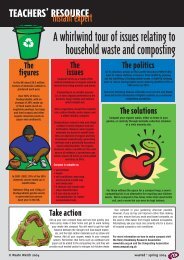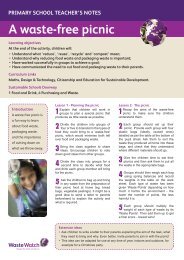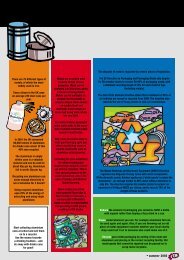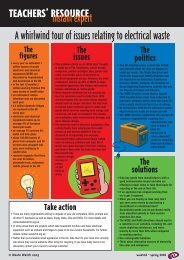You also want an ePaper? Increase the reach of your titles
YUMPU automatically turns print PDFs into web optimized ePapers that Google loves.
TEACHERS’ RESOURCEinstant expertA whirlwind tour of issuesrelating to packagingThefiguresIn 2001, the UK produced anestimated 9.3 million tonnes ofwaste packaging. Of this, 5.1million tonnes came fromhouseholds and the remaining4.2 million tonnes came fromcommercial and industrialsources.About a quarter of the waste inthe average household bin ispackaging waste, and food anddrink packaging represents70% of this.<strong>Packaging</strong> materials use largequantities of the world’snatural resources and currentlyaccount for around 5% oflandfill deposits.The UK is aiming to recycle justover one quarter of packaging– the minimum allowed underEuropean law.percentage of goods packaged indifferent materialsTheissuesDemands on packaging are high. It should be• consumer friendly to satisfy the consumers• product friendly to protect the content• environmentally friendly when manufactured ordisposed of.<strong>Packaging</strong> can be divided into three broad categories:• Primary packaging is the wrapping or containershandled by the consumer.• Secondary packaging is the term used to describelarger cases or boxes that are used to groupquantities of primary packaged goods for distributionand for display in shops.• Transit packaging refers to the wooden pallets, boardand plastic wrapping and containers that are used tocollate the groups into larger loads for transport, whichfacilitates loading and unloading of goods.Without packaging a great proportion of ourfoodstuffs would have a shorter shelf life and wouldnot reach the consumer in a fit condition.Mixed material packaging is often more resourceand energy efficient than single material packagingbut combining materials makes recycling difficult.For example, drinks cartons can consist of 75%paper, 20% polyethylene and 5% aluminum foil butthere is currently only one facility in the UK able toseparate these materials for recycling.The politicsIn 1994 member states of the EuropeanCommission reached an agreement on a directiveto reduce the amount of packaging waste. TheEuropean Directive on <strong>Packaging</strong> and <strong>Packaging</strong>Waste requires member states to• reduce the amount of packaging waste forfinal disposal• achieve certain packaging waste recoveryand recycling targets• ensure that packaging meets certainessential requirements.The solutionsThe best sort of packaging is that which can beused a number of times, such as pallets, reusableplastic crates, cardboard or wooden boxes, andmilk bottles.We can all reduce the impact of packaging waste by• buying products with less packaging orpackaging that can be easily recycled• buying milk in returnable bottles• going refillable – products from printing ink tocleaning fluids are available in refillable containers• buying products made from recycledpackaging materials• disposing of waste packaging thoughtfully byrecycling or composting• buying non-perishable goods in bulk.Take actionOrganise a waste free lunch at school to raise awareness of over-packaging and to emphasise thevalue of reuse. Make posters to advertise the day with illustrations of a wasteful and waste free lunch.Hold the event as a competition between classes and award prizes to the class that generates the leastamount of rubbish from their lunch.© Waste Watch 2004wasted • autumn 2004 5
TEACHERS’ RESOURCEprimary yearsGreen lunchboxIf you bring lunch, snacks or drinks into school you can try and makethose choices healthy and waste free. This activity will help you decide whatto put into your lunchbox.What to do• Draw a food pyramid based on the one below, with a recycling bin on oneside and a rubbish bin on the other.• Draw the pictures of the different types of food below and cut them out.You can colour them in too, if you have time.• On the food pyramid there are 4 categories – can you put the pictures ofthe food into the correct category?• Now look at the packaging that some of the food comes in – can any ofthat packaging be recycled? Can you recycle this at school or would youtake it home to be recycled? If you can do either of these put the pictureon the recycling bin.Draw pictures of these types of food• handful of nuts• pot of yoghurt• packet of cheese snacks• chunk of cheese• milk drink carton• foil wrapped cheese triangle• hot dog• packet of crisps• hard boiled egg in its shell• chocolate biscuit in a packet• homemade cookie• apple• Which packaging will end up in the rubbish bin? Put those pictures ontothe rubbish bin.• The food left on your food pyramid should have no packaging, will give youa healthy balanced diet and will create a waste free lunch.• Why do you think you have more of some types of food and less of others?• Use your pyramid and pictures to make a poster for the rest of your school– help all of your school to learn how to be healthy and waste free!Put each type of food into the correct categoryThe food pyramid has 4 sections1. Fatty and sugary foods – fats, oils and sweets2. Protein – dairy, meat, fish, beans, eggs, nuts & seeds3. Vitamins, minerals & fibre – fruit and vegetables4. Starchy carbohydrates – bread, cereals, rice and pasta• banana• carrot sticks• cherry tomatoes• packet of ‘fruit winders’• cut up apple in a bag• chunk of cucumber• sandwich in a plastic packet• sandwich in a lunch box• pasta salad in lunch box• rice salad in lunch box• jacket potato• homemade muesli bar1fats and sugars2proteinWill the packaging goin the rubbish bin?3vitamins, minerals and fibreCan you recyclethe packaging?4starchy carbohydrates6 autumn 2004 • wasted © Waste Watch 2004
TEACHERS’ RESOURCEsecondary yearsClosing the loopRecycling does not immediately occur when we drop a can, bottle or newspaper in the recyclingbin, it has only been recycled when that material is reprocessed, used to manufacture anew product and then bought by us. We call this ‘closing the loop’.If you buy recycled paper you areclosing the recycling loop.At the paper mill recycled paper is cleanedand made into new paper sheetsIf you simply throwaway your paper,the valuableresources andenergy used tomake it are lostforever.Closing the loop means that we need to input less and less new raw material into the cycle.What are the benefits of making and buying recycled?For the environment• Using recycled materials means that resources that could be used again are not justthrown away after their first use.The vast majority of resources used to manufacture productscannot be replaced and so will eventually run out, these are called non-renewableresources.• Recycling materials means that they do not need to be disposed of in landfill sites or byincineration, both of which have environmental consequences.• If we recycle instead of throwing away, fewer new materials need to be quarried or minedand fewer plantations need to be grown to make new things. Many parts of the world havealready been damaged by mining and quarrying, which destroy the natural environmentand wildlife habitats and may cause environmental and health problems for local people.• Making products from recycled materials uses less energy than making them from theraw material. For example, making aluminium cans from old ones uses only one twentiethof the energy needed to make them from raw materials.• Recycling materials results in less pollution than making them from new. Recycling oldglass bottles, can cut pollution by up to 20% and reduce the demand for water by half.Making bags from recycled polythene rather than raw materials produces only a third ofthe sulphur dioxide and half of the nitrous oxide as well as only using one-eighth as muchwater.For manufacturers• It is usually cheaper to recycle old materials than to purchase new raw materials. Thisis often because recycled materials may be available locally whereas new raw materialsmay have to be transported over long distances, often from overseas.• Using recycled materials can also make a manufacturer appear more environmentallyfriendly and socially responsible, persuading some consumers to purchase items fromthat manufacturer rather than another.For consumers• The more people that buy recycled, the more the market for recycled products is stimulated.Over time, this should result in falling costs for items made from recycled materials.• Buying recycled gives consumers a chance to ‘do their bit’ for the environment.• Buying items made from recycled materials may make consumers more aware of theway in which recycling operates.Are you a green consumer?You may not be aware of having bought anything made from recycled materials. If so, thinkagain! All of these can be made from recycled materials.• Newspapers – approximately 65% of the U.K.’s local and national newspapers areprinted on recycled paper.• Anything in a glass bottle – In the U.K. bottles and jars, may be made of as much as90% recycled material, although the average is much lower at around 25%.• Drinks cans – nearly 60% of the aluminium used in the U.K. has been previously recycled.• Fleeces, gloves or winter hats – plastic bottles can be recycled as fleece material tomake these warm items of clothingActivity – fill the house with rubbishThe range of products made from recycled materials is surprisingly wide and is also constantlychanging and expanding. The best way to keep up with this is by using the internetto look for these products.Make use of the internet to find at least one recycled product that could be used ineach of the following areas of a house:• kitchen• living room and/or dining room• child’s bedroom or playroomHere is a list of useful websites to start you off• www.recycledproducts.org.uk• www.recyclenow.com• www.remarkable.co.uk• bathroom and/or toilet• home office• garden• www.greenstat.co.uk• www.cutouts.net• www.naturalcollection.comMore can be found be typing ‘recycled products’ (or similar) into a search engine.Recycle symbolsmetalsMost beverage and food cans can berecycled. Look out for these symbolscardboardThis symbol, called the Mobius loop, isfound most commonly on cardboard andtells you that the card can be recycled. Ifthere is a percentage in the middle of thesymbol it denotes what amount of the cardboardis made from recycled material.<strong>Packaging</strong> often bears symbols that will help you decide if they are good for the environment.Some of these symbols tell you if a material can be recycled, while others tell you the recycled content.plasticsThis small triangle with a number, and oftensome letters, is found on plastic packagingand tells you what type of plastic the item ismade from. For example the number 3denotes PVC or Polyvinyl chloride. Try andbuy plastics that can be recycled by yourlocal recycling facilities.glassWhilst most glass containers arerecyclable, this symbol reminds consumersto recycle glass jars and bottles, either atbottle banks or, where available, throughkerbside collection schemes.green dotThe German Green Dot symbol is oftenfound on packaging and means that themanufacturer has paid a fee towards thepackaging recovery system in Germany.eco labelThe European Eco-label is awarded toproducts that meet a set of stringentenvironmental tests. The tests assess allaspects of a product’s life, often includingpackaging. About 400 products – fromwashing machines to footwear – currentlycarry the label.© Waste Watch 2004wasted • autumn 2004 7
TEACHERS’ RESOURCE world viewPlastic bags – a world viewSince plastic shopping bags were first used in 1957 in N. America, they havebecome one of the most commonly used types of packaging around theworld. In Britain we now use approximately 8 billion plastic bags a year,equivalent to 133 per person. Tied end to end they would go around theearth eight times! With so many plastic bags being produced it is importantto understand the impact they have on the environment. A plastic bag couldtake up to 1000 years to break down naturally when it is thrown away,though no one is really sure because plastic has not been around longenough to tell.The plastic bags we use in Britain come from as far away as factories inMalaysia, Thailand and China. So why are plastic bags a problem and whatare different countries doing around the world to solve it?South AfricaUntil recently, in South Africa the plastic carrier bag had become known asthe “national flower” because the bags littered the streets in such abundanceand were frequently blown into hedges and trees. This was despitethe innovative use of discarded bags by some South Africans to weave theminto new items such as purses, hats and scrubbing brushes.The government decided to put an end to the litter problem and put acomplete ban on the flimsy plastic bag. It is now illegal for retailers to handout plastic bags and if caught they face a fine of 100,000 rand or 10 yearsin prison! Shoppers now need to bring their own shopping bags or pay forthick reusable ones.AustraliaAustralian environment ministers are concerned about the harm discardedplastic bags cause to marine life when they end up in the rivers and sea. TheWorld Wildlife Fund for Nature estimates that more than 100,000 whales,turtles, seals and birds die through suffocation, entanglement and ingestionof plastic bags.Source: http://news.bbc.co.uk/1/hi/uk/1974750.stmThe government has set Australians a goal to reduce plastic bag consumptionby 50% by the end of 2004.IrelandSince the beginning of March 2002 shoppers in Ireland have been chargeda 9 pence tax on plastic bags to encourage them to use their own shoppingbags. Superquinn, one of the supermarket chains in Ireland, says that thenumber of plastic bags they now distribute has dropped by 97.5%.Other places around the worldBangladesh have put a complete ban on plastic bags after researchshowed that they could have contributedtowards major floods in thecountry between 1988 and 1998.The problem was caused by discardedplastic bags clogging up thedrainage system.In India cows often mistakeplastic bags for food, this can causeserious harm and some cows die ofstarvation or choking.Plastic bags are even big inNorth America, despite Hollywoodfilms featuring people leaving thesupermarket overburdened withpaper bags, four out of five grocery bags in North America are made fromplastic.UKAt the moment shoppers in Britain aregiven plastic bags free of charge, butwill Britain follow other countries andstart to charge people for plasticbags? A Mori poll showed that 63% ofBritish people would be prepared topay 10 pence tax on every plastic bag.One simple way to cut down onthe amount of plastic bags you consumeis to carry with you a reusableshopping bag. Whether this is an oldsturdy carrier bag or a cotton shoppingbag, it means you won’t pick upunwanted plastic bags every timeyou visit a shop.www.cleanup.com.au8 autumn 2004 • wasted © Waste Watch 2004
TEACHERS’ useful RESOURCE resourcesAll the information you need is out there on theinternet – somewhere! We tell you where to look.<strong>Recyclezone</strong>This website not only looksgood but is also one of the bestresources for teachers andchildren alike, with lots ofinformation and activities onwaste, recycling and sustainableresource use. The kidssections includes interactivegames such as the RubbishChallenge and the VirtualSchool, while the teacherssection gives lots of advice andideas for bringing wasteeducation into the classroom.www.recyclezone.org.ukWaste OnlineThis website contains mountainsof useful information on avariety of waste issues. Thedirect web link below will takeyou to a valuable resourcesheet that not only providescomprehensive facts and figuresbut also considers theenvironmental impact ofpackaging as a whole.www.wasteonline.org.uk/resources/InformationSheets/<strong>Packaging</strong>.htmFriendly <strong>Packaging</strong>This website aims to discussand investigate packaging ofthe future. The site is welldesigned and simple to use andwould therefore work as a usefulresearch tool for schools.There is lots of information providedand is well worth a look.www.friendlypackaging.org.ukBritish GlassA fun website containing lots ofinteresting sections used to promotethe recycling of glass.Children will be able to discoverhow glass is formed, discoversome ‘funky facts’ and testthemselves on the history of© Waste Watch 2004glass time line. Did you knowit was as early as 30 BC theydiscovered how to blow glassinto different shapes?www.recyclingglass.co.ukAluproThis is the home site of the UKAluminium <strong>Packaging</strong> RecyclingOrganisation. It is a simple touse and attractive site dedicatedto promoting the benefitsand environmental effects ofrecycling aluminium cans. Theeducation section of the siteprovides information aboutsetting up school projects withadded lesson plans and correspondingteacher notes to boot!www.alufoil.co.ukEnvironmentalInformation ExchangeThis is a good teacher’s resourcesite. Follow clear and simpleicons to information that suggestsways to manage wasteincluding waste packaging.www.brookes.ac.uk/eie/index.htmThe Industry Council for<strong>Packaging</strong> and theEnvironmentINCPEN is a non profit organisationwhich focuses on theuse of packaging and its overallenvironmental impact. Theeducation section of the sitecontains a large section of factsheets covering varying aspectsof packaging.www.incpen.orgSteel Can RecyclingFind lots of information aboutthe use of steel in packagingbut also consider the historyof steel can recycling. Thewebsite also offers a freecurriculum pack containing arange of educational materials.www.scrib.orgOllie RecyclesA very useful, pupil friendlywebsite covering all aspects ofrecycling. It contains a sectionof simple facts and figuresabout recycled steel packaging.www.ollierecycles.com/uk/html/corus.htmlRecycled ProductsGuideNot sure where to buy recycledpackaging? There are loads ofideas and contact addresses tobe found on this site.www.recycledproducts.org.ukIt’s out there on the internet – recycled artOne great way of saving money and resources is using oldpackaging instead of new materials for arts and crafts projects.This is certainly nothing new, as anyone who haswatched Blue Peter over the years can testify! Increasingly,professional artists are using recycled materials, includingpackaging, to make their art.Aluminous publishing is an American company that specialisesin making things from aluminium drinks cans – thefantastic wreath and bells on our cover is just one of their brilliantdesigns. They also have a really interesting links page toother websites around the world using recycled materials.Prepare to be amazed by what artists are making from thematerials some people think of as just rubbish. This includesUK designer Anna C. Roebuck who has developed her ownunique method of turning everyday plastic shopping bags intobeautiful objects including screens, jewellery and ‘lightpieces’.www.aluminouspublishing.com/recycled_art.phpwww.bags2riches.co.ukAnna Roebuck with lampshades made from recycled plastic shopping bagswasted • autumn 2004 9
TEACHERS’ RESOURCESProducts and PackagesEvery issue we review an education resource thatteachers can use in the classroom. Here we take a lookat Products and Packages, an education pack producedby the Industry Council for <strong>Packaging</strong> and theEnvironment (INCPEN).The audienceProducts and Packages – key stage 3 is just one of the education materials producedby INCPEN for use by teachers. The resource is aimed at key stage 3 pupils studyingdesign and technology. Many areas of this curriculum can be taught through packagingby looking at the wide range of functions in taking a product from production to thepoint of consumption. Similarly, packaging uses high tech manufacturing techniquesand a wide range of design criteria.Datesfor yourdiary24 November – 5 DecemberNational Tree Week is the Tree Council’s festival to markthe start of the tree planting season, and a nationwidecelebration of trees and woods. Across the country therewill be lots of opportunities to plant trees, or to take partin events, walks, talks, songs, story-telling and treedressing. www.treecouncil.org.uk9 DecemberWaste Watch’s annual seminar in London is set to starttongues wagging on the subject of sustainable consumption.Possession Obsession speakers will address the questionof whether the ‘spend, spend, spend’ culture reallymakes us happier, and whether the environment can withstandthe pressure. www.wastewatch.org.ukThe layoutThe resource comes as a folder containing an easy to photocopy book of activity sheets,a set of colourful case studies, and a pamphlet containing teacher’s notes. The book ofactivity sheets contains 12 practical tasks including hands on skills, experimentationand research. These are laid out clearly and include good diagrams and pictures.The case studies detail different products such as televisions, garden peas, aspirins andwashing up liquid. They consider the special requirements that each different producthas of the packaging used to transport and display it. There are sections on the designand manufacture of packaging and finally a section on how the packaging can be disposedof. Sadly, this only provides a brief discussion of recycling and does not ask childrento think of ways to use less packaging. The case studies are well illustrated withcolour photographs. Finally, there are teacher’s notes explaining how to get the mostfrom the pack and links with the national curriculum.Curriculum linksINCPEN has produced this resource in cooperation with the University of SalfordTechnology Education Development Unit, and it is obvious that a lot of thought has gonein to meeting the curriculum requirements. The pack is useful for teaching the designand technology curriculum in England and Wales, and for supporting the key featuresof 5-14 environmental studies curriculum in technology, in Scotland. INCPEN also producecross-curricular education resources on packaging and managing waste.25 DecemberMerry Christmas from everyone at Waste Watch! Give apresent to the planet and make sure you enjoy a greenyuletide by following the tips on our Christmas informationsheet. You can download it from our online database.www.wasteonline.org.uk1 January 2005Happy new year! 2005 marks the start of the UN decadefor education for sustainable development. Over the next10 years the work we do will be at the forefront of effortsto improve sustainability. We can all make a difference!www.unesco.org4 January 2005The Christmas Card Recycling Scheme is an excellent wayof cutting down on the waste associated with the festiveseason. During January you can drop unwanted cards intospecial bins provided in high street branches of WHSmithor Tesco supermarkets. Proceeds will help the WoodlandTrust protect and plant trees around the UK.www.woodland-trust.org.ukOverall, this is a well designed education pack. One criticism of it is that it doesn’t promotethe issue of waste reduction with regard to packaging waste.To obtain a copy of any of these resources visit www.incpen.org.uk12 autumn 2004 • wasted



